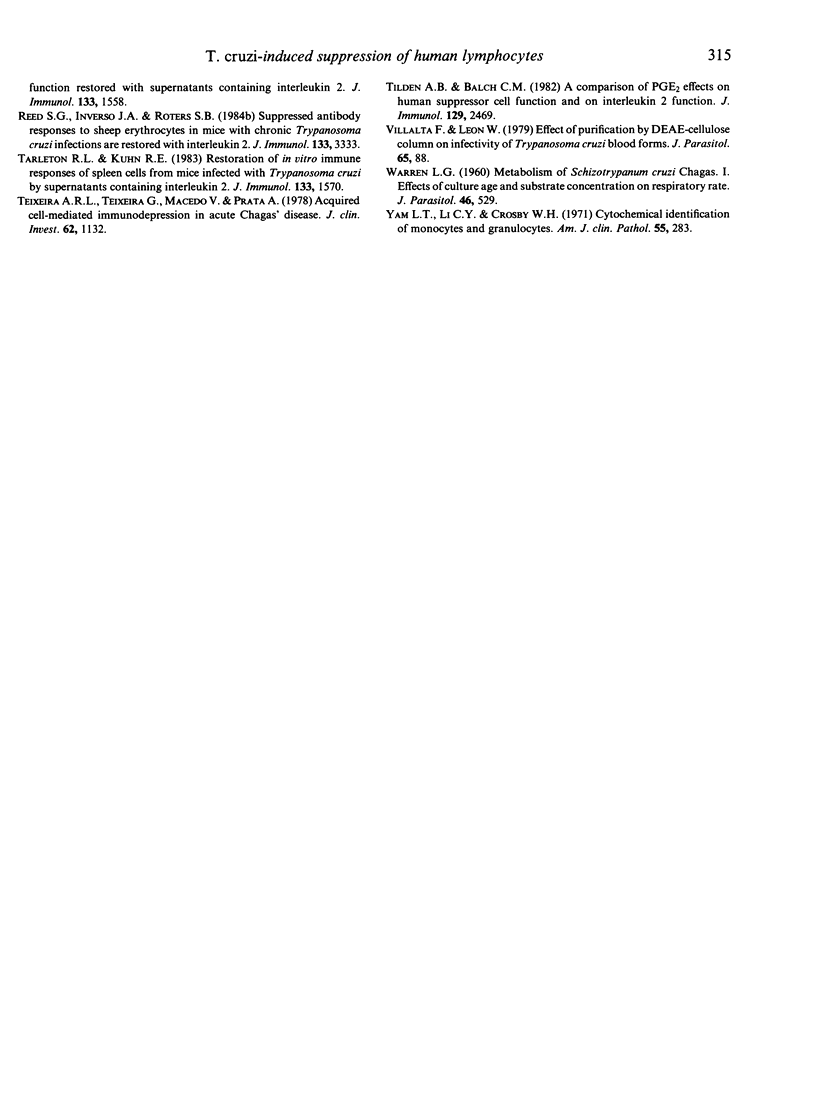Abstract
Virtually nothing is known about the basis for the immunosuppression associated with human T. cruzi infection. We have used an in vitro system to explore this effect. Incubation of human peripheral blood mononuclear cells (PBMC) with blood forms of T. cruzi abrogated their responses to suboptimal, optimal and supraoptimal doses of Con A, PHA or PWM, whether or not monocytes were depleted. Killed parasites were not suppressive. Maximal suppression (74%) occurred when the parasites were present during the entire culture period (96 hr), although significant suppression (33%) was seen when the organisms were added 24, 48 or 72 hr after initiation, suggesting that the early stages of lymphocyte activation had been impaired and that a second generation of cells was also affected. The 4-day supernatant medium of a T. cruzi suspension supported PBMC responses to Con A as well as medium incubated alone, indicating that suppression did not result from parasite removal of essential nutrients. Furthermore, 96 hr after mitogenic stimulation, the proportions of viable PBMC in cultures containing or lacking the parasites were comparable. Although T. cruzi binds Con A and PHA, this absorption was not the cause of reduced responsiveness since optimal concentrations of Con A and PHA remained in solution under our conditions. Levels of IL-2 in PHA-stimulated PBMC cultures were markedly reduced in the presence of T. cruzi. However, exogenous IL-2 failed to restore lymphocyte responsiveness. T. cruzi neither absorbed nor inactivated IL-2. Thus, the noted suppression appeared to involve at least deficient production and utilization of IL-2.
Full text
PDF






Selected References
These references are in PubMed. This may not be the complete list of references from this article.
- Brener Z. Immunity to Trypanosoma cruzi. Adv Parasitol. 1980;18:247–292. doi: 10.1016/s0065-308x(08)60401-7. [DOI] [PubMed] [Google Scholar]
- Budzko D. B., Kierszenbaum F. Isolation of Trypanosoma cruzi from blood. J Parasitol. 1974 Dec;60(6):1037–1038. [PubMed] [Google Scholar]
- Clinton B. A., Ortiz-Ortiz L., Garcia W., Martinez T., Capin R. Trypanosoma cruzi: early immune responses in infected mice. Exp Parasitol. 1975 Jun;37(3):417–425. doi: 10.1016/0014-4894(75)90012-0. [DOI] [PubMed] [Google Scholar]
- Cunningham D. S., Kuhn R. E. Trypanosoma cruzi-induced suppression of the primary immune response in murine cell cultures to T-cell-dependent and -independent antigens. J Parasitol. 1980 Feb;66(1):16–27. [PubMed] [Google Scholar]
- Harel-Bellan A., Joskowicz M., Fradelizi D., Eisen H. Modification of T-cell proliferation and interleukin 2 production in mice infected with Trypanosoma cruzi. Proc Natl Acad Sci U S A. 1983 Jun;80(11):3466–3469. doi: 10.1073/pnas.80.11.3466. [DOI] [PMC free article] [PubMed] [Google Scholar]
- Hayes M. M., Kierszenbaum F. Experimental Chagas' disease: kinetics of lymphocyte responses and immunological control of the transition from acute to chronic Trypanosoma cruzi infection. Infect Immun. 1981 Mar;31(3):1117–1124. doi: 10.1128/iai.31.3.1117-1124.1981. [DOI] [PMC free article] [PubMed] [Google Scholar]
- Kierszenbaum F. Immunologic deficiency during experimental Chagas' disease (Trypanosoma cruzi infection): role of adherent, nonspecific esterase-positive splenic cells. J Immunol. 1982 Nov;129(5):2202–2205. [PubMed] [Google Scholar]
- Lima M. F., Kierszenbaum F. Biochemical requirements for intracellular invasion by Trypanosoma cruzi: protein synthesis. J Protozool. 1982 Nov;29(4):566–570. doi: 10.1111/j.1550-7408.1982.tb01337.x. [DOI] [PubMed] [Google Scholar]
- Maleckar J. R., Kierszenbaum F. Inhibition of mitogen-induced proliferation of mouse T and B lymphocytes by bloodstream forms of Trypanosoma cruzi. J Immunol. 1983 Feb;130(2):908–911. [PubMed] [Google Scholar]
- Pereira M. E., Loures M. A., Villalta F., Andrade A. F. Lectin receptors as markers for Trypanosoma cruzi. Developmental stages and a study of the interaction of wheat germ agglutinin with sialic acid residues on epimastigote cells. J Exp Med. 1980 Nov 1;152(5):1375–1392. doi: 10.1084/jem.152.5.1375. [DOI] [PMC free article] [PubMed] [Google Scholar]
- Ramos C., Schädtler-Siwon I., Ortiz-Ortiz L. Suppressor cells present in the spleens of Trypanosoma cruzi-infected mice. J Immunol. 1979 Apr;122(4):1243–1247. [PubMed] [Google Scholar]
- Reed S. G., Inverso J. A., Roters S. B. Heterologous antibody responses in mice with chronic T. cruzi infection: depressed T helper function restored with supernatants containing interleukin 2. J Immunol. 1984 Sep;133(3):1558–1563. [PubMed] [Google Scholar]
- Reed S. G., Inverso J. A., Roters S. B. Suppressed antibody responses to sheep erythrocytes in mice with chronic Trypanosoma cruzi infections are restored with interleukin 2. J Immunol. 1984 Dec;133(6):3333–3337. [PubMed] [Google Scholar]
- Tarleton R. L., Kuhn R. E. Restoration of in vitro immune responses of spleen cells from mice infected with Trypanosoma cruzi by supernatants containing interleukin 2. J Immunol. 1984 Sep;133(3):1570–1575. [PubMed] [Google Scholar]
- Teixeira A. R., Teixeira G., Macêdo V., Prata A. Acquired cell-mediated immunodepression in acute Chagas' disease. J Clin Invest. 1978 Dec;62(6):1132–1141. doi: 10.1172/JCI109232. [DOI] [PMC free article] [PubMed] [Google Scholar]
- Tilden A. B., Balch C. M. A comparison of PGE2 effects on human suppressor cell function and on interleukin 2 function. J Immunol. 1982 Dec;129(6):2469–2473. [PubMed] [Google Scholar]
- WARREN L. G. Metabolism of Schizotrypanum cruzi Chagas. I. Effect of culture age and substrate concentration on respiratory rate. J Parasitol. 1960 Oct;46:529–539. [PubMed] [Google Scholar]
- Yam L. T., Li C. Y., Crosby W. H. Cytochemical identification of monocytes and granulocytes. Am J Clin Pathol. 1971 Mar;55(3):283–290. doi: 10.1093/ajcp/55.3.283. [DOI] [PubMed] [Google Scholar]


